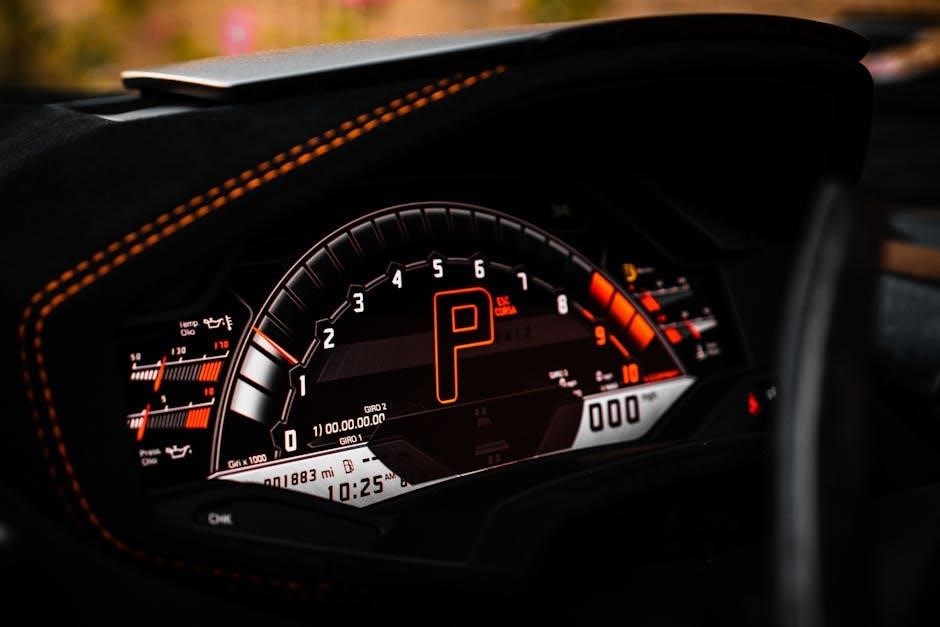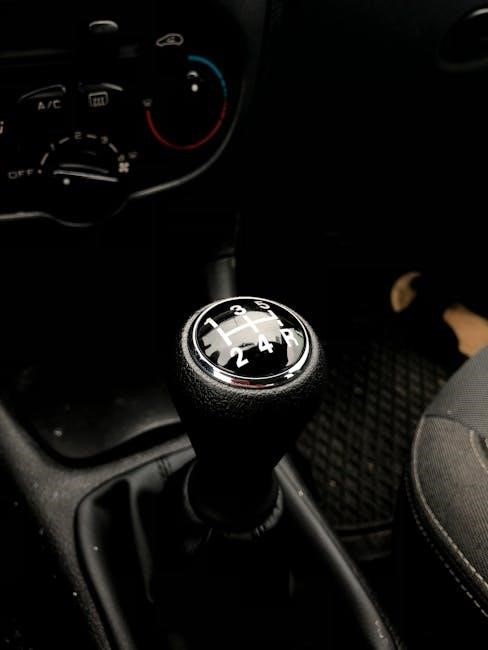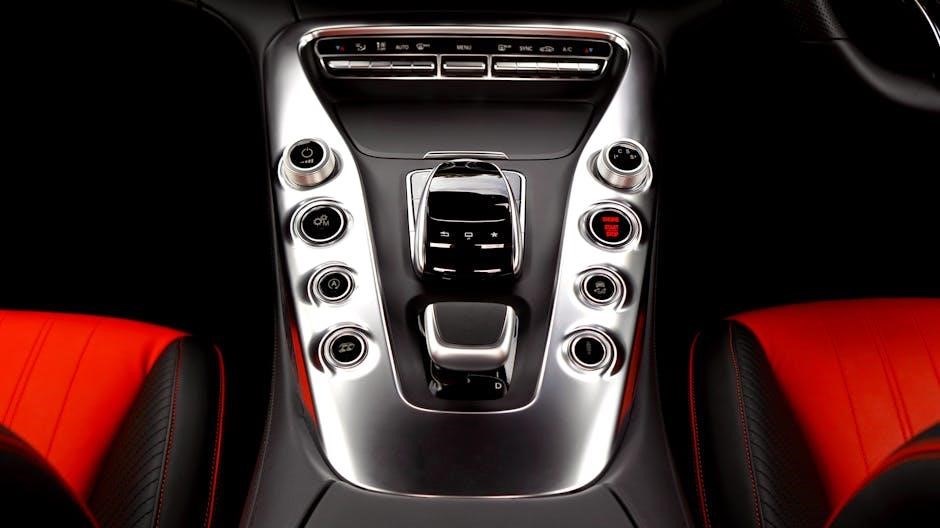Many drivers wonder if using manual mode in an automatic vehicle is beneficial or harmful․ This section explores the concept, its benefits, and drawbacks, helping you decide when to use it effectively․
What is Manual Mode in an Automatic Transmission?
Manual Mode in an automatic transmission allows drivers to manually shift gears using paddle shifters or the gearshift, offering more control over gear changes․ Unlike a fully manual transmission, the car still handles some automatic functions, such as preventing stalling or over-revving․ This feature is designed for specific driving conditions, like steep hills or towing, where better control is beneficial․ However, it differs from a traditional manual, as the car may still automatically adjust gears to some extent․ Using Manual Mode can provide a sportier driving experience but may not be necessary or advisable for everyday driving, potentially leading to wear on the transmission if misused․
Why Do Drivers Consider Using Manual Mode?
Drivers consider using Manual Mode for greater control over gear shifts, especially in challenging conditions like steep hills or towing heavy loads․ It allows for better management of engine power and torque, which can be advantageous in specific driving scenarios․ Additionally, some drivers prefer Manual Mode for a more engaging and sporty driving experience․ It provides a sense of control similar to driving a manual transmission vehicle but without the need for a clutch pedal․ However, improper use can lead to increased wear on the transmission, making it essential to understand when and how to use this feature effectively․

Pros of Driving an Automatic in Manual Mode
Manual Mode offers enhanced control, improved fuel efficiency in specific conditions, and a more engaging driving experience, making it beneficial for certain scenarios without compromising convenience․
Better Control on Steep Hills
Manual mode provides superior control when navigating steep inclines or declines․ By manually selecting gears, drivers can maintain optimal engine braking, reducing the need for frequent brake use․ This is especially beneficial when driving downhill, as it helps prevent overheating and maintains stability․ Uphill, manual mode allows drivers to stay in a lower gear, ensuring consistent power delivery and avoiding unwanted gear shifts․ This enhanced control reduces the risk of wheel spin or loss of traction, making it safer and more efficient for hilly or mountainous terrains․
Improved Fuel Efficiency in Certain Conditions
Manual mode can enhance fuel efficiency in specific driving scenarios․ By manually controlling gear shifts, drivers can avoid unnecessary upshifting or downshifting, which can waste fuel in stop-and-go traffic or uneven terrain․ For example, holding a lower gear while climbing a moderate hill can prevent excessive RPM spikes, optimizing engine performance․ Additionally, in steady-speed driving, such as on flat highways, staying in a higher gear reduces engine strain and fuel consumption․ However, this benefit depends on the driver’s skill and the situation, as improper shifting can negate efficiency gains․
Enhanced Driving Experience for Enthusiasts
Manual mode offers enthusiasts a greater sense of control and precision, making driving more engaging․ By actively shifting gears, drivers can tailor their acceleration and deceleration to suit their driving style, enhancing the connection with the vehicle․ This hands-on approach can heighten the thrill of driving, especially on winding roads or during sporty maneuvers․ For those who enjoy an immersive driving experience, manual mode transforms the car into a more responsive and interactive machine, delivering a sense of satisfaction that automatic mode alone may not provide․
Reduced Wear on Brakes During Descents
Using manual mode during descents can significantly reduce wear on brakes․ By downshifting, drivers engage engine braking, which slows the vehicle without relying heavily on the brake pedals․ This is particularly beneficial in hilly or mountainous regions, where constant braking can overheat and degrade brake components․ Engine braking helps maintain control and reduces the frequency of braking, thereby extending the life of brake pads and rotors․ This technique is especially advantageous for drivers who frequently encounter steep inclines or declines, as it minimizes strain on the braking system while improving overall vehicle control․

Cons of Driving an Automatic in Manual Mode
Engaging manual mode during descents can reduce brake wear by utilizing engine braking, which lessens the need for frequent braking and helps extend the life of brake components․
Potential Damage to Transmission
Driving an automatic in manual mode can potentially damage the transmission if not done correctly․ Incorrect shifting, such as shifting gears without enough torque or at inappropriate RPM levels, can strain transmission components․ Frequent or abrupt manual shifts may lead to wear on clutches, bands, and gear sets․ Additionally, riding the brakes while in manual mode can cause the transmission to overheat, further risking damage․ Modern automatic transmissions are designed to handle manual shifting within limits, but consistent misuse can shorten their lifespan․ It’s essential to follow the manufacturer’s guidelines to avoid costly repairs․
Increased Risk of Overheating
Driving an automatic in manual mode can increase the risk of overheating, especially during aggressive driving or frequent shifting․ The transmission works harder to maintain control, generating excessive heat․ Prolonged use in hilly or stop-and-go conditions can strain the system further․ Modern transmissions have cooling mechanisms, but improper shifting or sustained high RPMs can overwhelm them․ Overheating damages internal components and reduces transmission lifespan․ Monitoring the temperature gauge and avoiding excessive manual shifting in demanding conditions is crucial to prevent long-term harm to the vehicle․ Always follow the manufacturer’s recommendations for manual mode usage․
Reduced Convenience for Daily Commuting
Using manual mode in an automatic vehicle can reduce the convenience of daily commuting․ Constantly shifting gears, especially in heavy traffic, can be tiring and less smooth compared to letting the transmission handle it automatically․ For drivers who value ease and comfort, manual mode defeats the purpose of owning an automatic vehicle․ It adds unnecessary complexity to routine driving, making commutes feel more like a chore than a seamless experience․ This is particularly true in stop-and-go traffic, where frequent shifting can become frustrating and less efficient than relying on the vehicle’s automatic capabilities․
Higher Risk of Driver Error
Driving an automatic in manual mode increases the risk of driver error, particularly for inexperienced drivers․ Improper shifting, such as shifting too early or late, can strain the engine or transmission․ Over-revving or lugging the engine can lead to poor performance or even damage․ Additionally, the added complexity of manual shifting can distract drivers, especially in stressful situations, increasing the likelihood of mistakes․ This makes manual mode less forgiving for those not fully accustomed to its use, potentially leading to unsafe driving conditions if not handled carefully․

When Should You Use Manual Mode?
Use manual mode during hill climbs, towing, or heavy traffic for better control․ It’s ideal for sporty driving or emergencies requiring precise gear shifts to enhance performance and safety․
- Hilly or mountainous terrain for speed control․
- Towing heavy loads to maintain engine braking․
- Heavy traffic for constant speed adjustments․
- Sporty driving to optimize acceleration and performance․
Driving in Hilly or Mountainous Terrain
Manual mode is highly beneficial when driving in hilly or mountainous regions․ It allows drivers to maintain better control over speed and gear selection, reducing the risk of overheating and brake wear․ By manually downshifting before descents, drivers can engage engine braking, which helps maintain a steady speed and reduces reliance on the brakes․ This is especially useful on steep inclines, where automatic transmissions might struggle to adapt․ Using manual mode in such terrain ensures smoother acceleration and deceleration, making the driving experience safer and more controlled․ It’s a practical choice for navigating challenging elevation changes effectively․
Towing Heavy Loads
Using manual mode when towing heavy loads can provide better control over gear shifts, helping to maintain optimal engine RPM․ This reduces strain on the transmission and engine, minimizing the risk of overheating․ Manual mode allows drivers to select lower gears for steady acceleration and deceleration, which is crucial when towing trailers or heavy equipment․ Engine braking in manual mode also reduces wear on the brakes, especially during descents․ This feature is particularly useful in hilly or uneven terrain, where automatic transmissions might struggle to adapt․ Proper use of manual mode can enhance safety and stability while towing heavy loads effectively․
Driving in Heavy Traffic or Stop-and-Go Conditions
Engaging manual mode in heavy traffic or stop-and-go conditions can offer better control over gear shifts, reducing abrupt transitions․ By manually selecting lower gears, drivers can maintain smoother acceleration and deceleration, which is beneficial in congested areas․ This reduces strain on the transmission and minimizes unnecessary shifting by the automatic system․ Manual mode also allows drivers to hold a specific gear for consistent speed, which can improve fuel efficiency in traffic jams․ However, it requires constant attention, which may increase driver fatigue in prolonged stop-and-go situations․
Sporty or Performance Driving
Manual mode can enhance the driving experience for enthusiasts seeking a sportier feel․ By allowing direct control over gear shifts, drivers can optimize acceleration and responsiveness, especially when pushing the vehicle’s performance limits․ This feature enables precise control during sharp turns or rapid acceleration, making it ideal for spirited driving․ It also provides a more engaging connection between the driver and the vehicle, which many find exhilarating․ However, it’s best reserved for open roads or track conditions, as it may not offer benefits in everyday driving scenarios․

When Should You Avoid Manual Mode?
Avoid manual mode during normal city driving, flat highways, or inclement weather, as it offers no benefits and may increase effort or risk of errors․
Normal City Driving
In normal city driving, manual mode is unnecessary and may even be counterproductive․ Frequent stops, starts, and low-speed maneuvers are better handled by the automatic system, which optimizes smoothness and convenience․ Using manual mode in such conditions can lead to a jerky ride, increased driver fatigue, and potential wear on the transmission․ Additionally, constant shifting in traffic can reduce fuel efficiency and increase engine strain․ The automatic system is designed to handle city driving efficiently, making manual mode redundant and potentially harmful to the vehicle’s performance and longevity in these scenarios․
Flat Highways
Driving an automatic in manual mode on flat highways is generally unnecessary and may lead to discomfort or inefficiency․ The automatic system is designed to maintain optimal gear selection for steady speeds, ensuring smooth acceleration and fuel efficiency․ Manual shifting on flat roads can disrupt this balance, potentially causing jerky acceleration or unnecessary wear on the transmission․ Additionally, constant speed on flat terrain doesn’t require manual control, making the effort redundant․ Sticking to automatic mode on highways preserves comfort, efficiency, and reduces the risk of transmission strain caused by frequent or improper shifting․
Inclement Weather Conditions
Driving an automatic in manual mode during inclement weather, such as heavy rain, snow, or ice, is not recommended․ Manual shifting can reduce traction and stability, as it interrupts the transmission’s ability to optimize torque delivery․ This can lead to wheelspin or loss of control, especially on slippery surfaces․ Additionally, the automatic system’s adaptive capabilities are better suited to handle unpredictable conditions by maintaining smoother power delivery․ Using manual mode in such weather increases the risk of skidding or accidents, making it safer to rely on the vehicle’s automatic functions for improved stability and control․
If You’re Not Familiar with Manual Shifts
Using manual mode in an automatic vehicle when unfamiliar with manual shifting can lead to poor control and potential damage․ Incorrect gear shifts may cause the engine to lug or over-rev, straining the transmission․ Novice drivers may also hesitate or make abrupt shifts, leading to rough acceleration or deceleration․ This can result in reduced fuel efficiency, uneven tire wear, or even mechanical damage․ It’s crucial to practice manual shifting in a safe, controlled environment before relying on it in real-world driving scenarios to avoid unintended consequences and ensure smooth operation of the vehicle․

How Manual Mode Affects the Vehicle’s Performance
Manual mode offers more control, optimizing performance in specific conditions, but improper use can reduce efficiency and stress the transmission, highlighting the need for careful operation․
Impact on Acceleration
Manual mode allows drivers to control gear shifts, which can enhance acceleration in specific scenarios․ By manually selecting lower gears, drivers can access more torque, improving responsiveness during uphill climbs or overtaking․ However, improper shifting, such as riding the clutch or holding gears too long, can strain the engine and transmission․ Additionally, aggressive downshifting may cause unnecessary wear, while failing to shift up promptly can lead to engine over-revving․ Balancing these factors ensures optimal acceleration without compromising the vehicle’s health;
Effect on Fuel Consumption
Driving an automatic in manual mode can influence fuel consumption, depending on usage․ In situations like uphill driving or towing, manual mode can improve efficiency by preventing excessive gear hunting․ However, aggressive driving or frequent shifting can lead to higher fuel use․ Additionally, holding lower gears for too long may increase engine RPMs, consuming more fuel․ Conversely, smooth and intentional shifting can optimize fuel economy․ Proper technique is key to balancing efficiency and performance, but improper use may negate potential benefits and increase consumption․
Influence on Engine and Transmission Health

Using manual mode in an automatic vehicle can impact engine and transmission health․ Proper use, like avoiding abrupt shifts, helps maintain optimal engine RPMs and reduces strain on the transmission․ However, frequent or aggressive manual shifting can overheat the transmission and cause wear․ Inexperienced drivers may ride the clutch or mismanage gears, leading to premature wear on components․ Modern transmissions are built to handle manual mode, but improper technique can still cause damage․ Consistent, smooth shifting is key to preserving engine and transmission longevity․

Best Practices for Using Manual Mode
- Understand your vehicle’s manual mode features and limits․
- Practice in safe, low-traffic conditions to build skill․
- Avoid abrupt or unnecessary shifts to prevent damage․
- Monitor transmission temperature to ensure longevity․
Understand Your Vehicle’s Specific Features
Before using manual mode, familiarize yourself with your vehicle’s unique features․ Consult the owner’s manual to learn about gear ratios, shift points, and electronic controls․ Understand how your car’s transmission responds to manual shifts, including any adaptive systems that adjust to driving habits․ Knowing these specifics ensures you use manual mode effectively and safely, avoiding potential damage or unintended behavior․ This step is crucial for maximizing the benefits of manual mode while minimizing risks to your vehicle’s performance and longevity․
Start with Low Speeds and Empty Roads
Begin practicing manual mode in low-speed conditions and on empty roads to minimize risks․ Start in a safe environment like an empty parking lot to get accustomed to the gear shifts and how the vehicle responds․ Avoid sudden or harsh shifts, as they can strain the transmission․ Gradually increase your speed and complexity of driving scenarios as your confidence grows․ This approach helps you develop the necessary skills without exposing yourself or others to potential hazards․ It also allows you to understand the car’s behavior in manual mode better․
Avoid Frequent or Abrupt Shifts
Frequent or abrupt gear shifts in manual mode can put unnecessary strain on the transmission and engine․ Sudden shifts may cause wear and tear, especially in automatic transmissions not designed for constant manual control․ Smooth, deliberate shifts are better for maintaining performance and longevity․ Avoid jerky movements, as they can disrupt the car’s balance and lead to poor fuel efficiency․ Consistent, gradual shifts ensure a smoother ride and less stress on the vehicle’s components․ This approach helps preserve the transmission’s health and maintains optimal driving performance․
Monitor Transmission Temperature
Monitoring the transmission temperature is crucial when driving in manual mode․ Increased heat can damage the transmission over time․ Use a dashboard gauge or smartphone app to track it․ High temperatures may indicate excessive strain, especially in hot climates or during frequent shifting․ If the temperature rises, pull over and let the vehicle cool․ Modern transmissions are designed to handle moderate use, but prolonged overheating can lead to costly repairs․ Regular monitoring ensures the longevity and efficiency of your automatic transmission when using manual mode․

Common Misconceptions About Manual Mode
- Manual mode always improves performance and fuel efficiency․
- Manual mode is only beneficial for experienced drivers․
- Manual mode reduces wear on the transmission․
- Manual mode is unnecessary in modern automatics․
Myth: Manual Mode Always Improves Performance
Manual mode does not universally enhance performance․ While it offers better control, especially in specific conditions like hills or towing, it does not always guarantee improved acceleration or efficiency․ In normal driving scenarios, modern automatic transmissions often optimize performance better than manual mode․ Poor shifting techniques can even reduce efficiency and strain the transmission․ Thus, manual mode is most beneficial in particular situations rather than being a universal performance booster․
Myth: Manual Mode is Always Better for Fuel Efficiency
Manual mode is not inherently more fuel-efficient in all scenarios․ While it can help save fuel in specific conditions, such as driving uphill or towing, improper shifting or aggressive driving can negate any efficiency gains․ In fact, modern automatic transmissions often optimize fuel consumption better than manual mode in normal driving conditions․ Additionally, frequent manual shifting can increase fuel usage if not done smoothly․ The fuel efficiency benefit of manual mode largely depends on the driver’s skill level and the driving environment, making it a situational advantage rather than a universal rule․
Myth: Manual Mode is Only for Experienced Drivers
Manual mode is not exclusive to experienced drivers․ While familiarity with shifting can be helpful, it is not a strict requirement․ Many modern automatics with manual mode are designed to be user-friendly, allowing even novice drivers to benefit from better control in specific situations, such as towing or driving uphill․ However, improper use can still lead to transmission damage, regardless of experience level․ Learning how to use manual mode effectively is more important than the driver’s overall experience behind the wheel․

Real-World Examples and Case Studies
Drivers report manual mode helps prevent rollback on steep hills and improves control while towing․ However, improper use, like aggressive shifting, has caused transmission damage․
How Manual Mode Helped in Emergency Situations
In emergency situations, such as avoiding an accident or preventing rollback on a steep incline, manual mode provides drivers with immediate control over gear shifts․ By downshifting, drivers can reduce speed without relying on brakes, which can be especially useful when descending steep hills or sudden stops․ Some drivers have reported that manual mode helped them regain control during skidding or when the vehicle’s automatic system delayed response․ However, improper use can still cause damage, so it’s crucial to understand when and how to engage manual mode effectively in high-stakes scenarios․
Instances Where Manual Mode Caused Unintended Damage
Improper use of manual mode in automatic vehicles can lead to unintended damage; For instance, aggressive downshifting without coordinating with brake application can over-rev the engine, causing strain on the transmission․ Similarly, frequent or abrupt shifts in stop-and-go traffic can generate excessive heat, leading to overheating issues․ Ignoring the vehicle’s automatic safeguards, such as forcing a downshift when the system resists, can also result in costly repairs․ These scenarios emphasize the importance of understanding and respecting the vehicle’s limitations when using manual mode․
Driver Experiences with Manual Mode in Various Conditions
Drivers have reported mixed experiences using manual mode in automatic vehicles․ In mountainous regions, manual mode helps control speed on descents, reducing brake wear․ Some enthusiasts enjoy the added control and sporty feel, especially on winding roads․ However, in heavy traffic, constant shifting can be tedious and may lead to driver fatigue․ Improper use, such as sudden downshifts without coordinating with speed, can cause jerky movements or even damage․ Overall, experiences vary based on driving conditions, vehicle type, and the driver’s skill level, highlighting the need for cautious and informed use of manual mode․
Using manual mode in an automatic vehicle can enhance control and efficiency in specific situations but may pose risks if misused․ Drivers should weigh benefits against potential risks, considering their driving conditions and skill level․ Always follow manufacturer guidelines to ensure safe and effective use of manual mode․
Final Thoughts on Using Manual Mode
Using manual mode in an automatic vehicle can be beneficial for experienced drivers in specific scenarios, such as hilly terrain or performance driving․ However, it’s not without risks, as improper use may damage the transmission or lead to overheating․ Drivers should always prioritize understanding their vehicle’s capabilities and adhering to manufacturer guidelines․ While manual mode offers enhanced control and efficiency in certain conditions, it’s not a one-size-fits-all solution․ Weighing the advantages against potential risks is crucial for safe and effective use․ Ultimately, manual mode is a tool best reserved for skilled drivers in appropriate situations․
Recommendations for Drivers Considering Manual Mode
Drivers contemplating manual mode should first consult their vehicle’s owner’s manual to understand its specific features․ Start with low-speed, empty-road practice to build familiarity without risks․ Use smooth, intentional shifts to avoid stressing the transmission․ Avoid manual mode in normal city driving or flat highways, as it offers no benefits and may increase wear․ Always monitor transmission temperature, especially in demanding conditions; Inexperienced drivers should practice consistently before relying on manual mode․ Remember, manual mode is a tool—use it judiciously and only when conditions justify it․ Always prioritize safe, attentive driving regardless of mode․